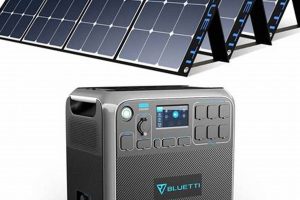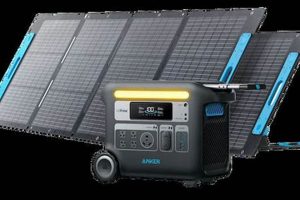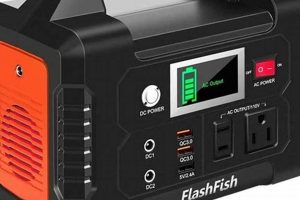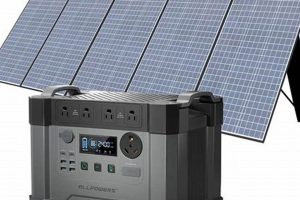Compact, independent power sources utilizing photovoltaic cells to convert sunlight into electricity offer a versatile solution for off-grid energy needs. These devices typically consist of solar panels, a battery for energy storage, and an inverter to convert direct current (DC) electricity to alternating current (AC) electricity, suitable for powering standard electronic devices. Imagine powering essential appliances during a camping trip or providing backup electricity during a power outage – this exemplifies the practical application of this technology.
The significance of these self-contained energy systems lies in their ability to provide clean, renewable power wherever and whenever needed. Historically, access to electricity in remote locations or during emergencies has relied heavily on noisy, polluting gasoline generators. This innovative approach reduces reliance on fossil fuels and promotes environmental sustainability. Furthermore, the portability factor allows for convenient transportation and deployment, making these devices invaluable for disaster relief, remote work, and recreational activities.
This article delves further into the technical aspects, practical applications, and selection criteria for choosing a suitable power solution tailored to specific energy requirements. Discussions will include topics such as battery capacity, solar panel efficiency, inverter types, and safety considerations to empower consumers to make informed decisions about their energy needs.
Tips for Utilizing Compact Solar Generators
Maximizing the effectiveness of a compact solar generator involves understanding its capabilities and limitations. The following tips offer guidance on optimal usage and maintenance.
Tip 1: Understand Power Needs: Accurately assess power requirements before selecting a unit. Calculate the combined wattage of devices intended for simultaneous use to ensure the generator’s capacity is sufficient.
Tip 2: Optimize Solar Panel Placement: Position solar panels for maximum sun exposure, ideally facing south in the northern hemisphere and north in the southern hemisphere. Keep panels clear of obstructions like trees or buildings.
Tip 3: Regularly Charge the Battery: Maintain battery health by recharging it regularly, even when not in use. Avoid completely depleting the battery, which can shorten its lifespan.
Tip 4: Monitor Battery Level: Track the battery’s state of charge to avoid unexpected power loss. Most units feature indicators or displays showing remaining capacity.
Tip 5: Protect from Extreme Temperatures: Extreme heat or cold can impact battery performance and lifespan. Store and operate the generator in moderate temperature ranges whenever possible.
Tip 6: Utilize Energy-Efficient Devices: Employing energy-efficient appliances and electronics will extend the generator’s runtime and reduce the load on the battery.
Tip 7: Proper Storage: When not in use, store the generator in a cool, dry place away from direct sunlight. Partially charge the battery every few months to maintain its health.
By adhering to these guidelines, users can ensure efficient operation, prolonged lifespan, and reliable performance from their compact solar generators, maximizing their investment and promoting sustainable energy practices.
This information provides a practical foundation for effectively using compact solar generators. The following section will conclude with a summary of key considerations and future trends in this evolving field.
1. Portability
Portability represents a defining characteristic of these power solutions, directly influencing their usability and applicability. This feature enables users to transport and deploy power generation capabilities in diverse locations, untethered from traditional power grids. Consider disaster relief scenarios where infrastructure is compromised; the ability to quickly deploy independent power sources becomes critical. Similarly, for remote work or recreational activities, portability allows access to electricity where conventional sources are unavailable. The compact form factor and lightweight design facilitate ease of movement, allowing individuals to carry these devices to campsites, hiking trails, or even construction sites.
This inherent portability expands the potential applications beyond traditional stationary generators. For example, field researchers can power sensitive equipment in remote ecosystems, while outdoor enthusiasts can maintain communication and charge essential devices during extended expeditions. Furthermore, in developing regions lacking reliable electricity infrastructure, portable units offer a viable solution for powering small businesses, medical clinics, or educational facilities. The practical significance of this portability lies in its ability to bridge the energy gap in various contexts, fostering resilience and enabling access to electricity where it’s needed most.
In conclusion, portability is not merely a convenient feature; it’s a transformative element that unlocks the potential of solar energy. By enabling access to electricity in off-grid locations, these devices empower individuals, communities, and industries. Addressing the challenge of ensuring reliable power access in remote or disaster-stricken areas highlights the broader societal impact of this crucial feature, fostering both individual empowerment and community resilience.
2. Solar Charging
Solar charging forms the foundation of portable solar powered generator functionality, enabling sustainable and independent power generation. This process directly converts sunlight into electricity, eliminating reliance on fossil fuels and reducing environmental impact. Understanding the nuances of solar charging is essential for maximizing the effectiveness and lifespan of these devices.
- Photovoltaic Cell Technology
Photovoltaic (PV) cells, commonly known as solar cells, are the core components responsible for converting sunlight into electricity. These cells utilize semiconductor materials to generate a direct current (DC) when exposed to photons. Crystalline silicon and thin-film technologies are prevalent in portable solar generators. Crystalline silicon offers higher efficiency but is more fragile, while thin-film is flexible and lightweight but less efficient. The choice of PV technology impacts the generator’s overall size, weight, and charging performance.
- Charging Efficiency and Factors
Charging efficiency is influenced by several environmental factors, including sunlight intensity, angle of incidence, and temperature. Optimal charging occurs when panels are perpendicular to direct sunlight. Cloud cover, shading, and extreme temperatures can reduce charging efficiency. Understanding these factors allows users to strategically position panels for maximum sunlight exposure and manage expectations regarding charging times.
- Maximum Power Point Tracking (MPPT)
Many portable solar generators incorporate MPPT controllers, which optimize the power transfer from the solar panels to the battery. MPPT technology dynamically adjusts the charging voltage and current to extract the maximum available power under varying sunlight conditions. This intelligent power management ensures efficient battery charging, minimizing wasted solar energy.
- Battery Charging and Management
The electricity generated by the solar panels is stored in a battery for later use. Battery capacity, measured in ampere-hours (Ah), determines the amount of energy that can be stored. Battery management systems (BMS) protect the battery from overcharging, over-discharging, and extreme temperatures, ensuring optimal battery health and longevity.
The interplay between these solar charging components and factors directly impacts the overall performance and usability of a portable solar powered generator. By understanding these elements, users can effectively harness solar energy, optimize charging efficiency, and prolong the lifespan of their devices, maximizing the benefits of this sustainable power solution.
3. Power Generation
Power generation stands as a central function of portable solar powered generators, defining their capacity to provide electricity for various applications. Understanding the underlying mechanisms and limitations of this power generation process is crucial for effective utilization. These devices transform solar energy captured by photovoltaic cells into usable alternating current (AC) electricity through a series of integrated components. The capacity of a unit, measured in watts, directly determines which devices it can power. A higher wattage allows for the operation of more power-intensive equipment, such as laptops or small appliances, while lower wattage units are suitable for charging smaller devices like phones or tablets. This output capability directly influences user choices based on anticipated power demands.
The conversion from DC electricity generated by the solar panels to AC electricity suitable for most consumer electronics occurs via an inverter. Inverter technology plays a crucial role in power generation quality and efficiency. Pure sine wave inverters produce cleaner electricity, safer for sensitive electronics, while modified sine wave inverters are more cost-effective but may not be compatible with all devices. This conversion process is essential for powering standard AC-powered devices using the DC electricity generated from solar energy. For instance, during a camping trip, a portable solar generator can power essential lighting, cooking equipment, or communication devices, providing off-grid access to electricity. In emergency situations, these generators can serve as a backup power source for essential appliances like refrigerators or medical equipment, enhancing safety and resilience.
Effective power generation relies on the seamless integration of solar panels, battery storage, and inverter technology. Understanding the wattage limitations, inverter type, and overall system efficiency allows users to make informed decisions regarding device compatibility and runtime expectations. This knowledge empowers users to optimize power usage, ensuring their portable solar generator effectively meets their specific energy needs. Considering these factors contributes significantly to maximizing the utility and value of these devices in diverse off-grid or emergency power scenarios.
4. Energy Storage
Energy storage represents a critical component of portable solar powered generators, enabling continuous power availability regardless of sunlight conditions. This functionality bridges the gap between solar energy generation, which is intermittent, and consistent power demand. Batteries serve as the primary energy storage medium, accumulating electricity generated by the solar panels during periods of sunlight. This stored energy can then be utilized to power devices during nighttime or cloudy conditions, ensuring uninterrupted operation. Battery capacity, typically measured in ampere-hours (Ah) or watt-hours (Wh), directly determines the amount of energy that can be stored and consequently the duration for which devices can be powered. Choosing an appropriate battery capacity is essential for matching power supply with anticipated demand. For instance, a higher capacity battery is required to power energy-intensive appliances for extended periods compared to charging smaller devices intermittently. This careful consideration of energy storage capacity is crucial for optimizing the usability and effectiveness of portable solar generators.
Several battery chemistries are commonly employed in portable solar generators, each with its own advantages and disadvantages. Lead-acid batteries are cost-effective but have a shorter lifespan and lower energy density. Lithium-ion batteries offer higher energy density, longer lifespan, and improved performance in extreme temperatures, but come at a higher cost. Understanding the trade-offs between different battery technologies allows for informed selection based on specific application requirements. Practical applications demonstrate the importance of energy storage. Consider a scenario where a portable solar generator powers essential medical equipment during a natural disaster, where grid power is unavailable. The battery’s stored energy ensures continuous operation of life-saving devices, highlighting the critical role of energy storage in emergency preparedness. Similarly, in remote areas lacking electricity infrastructure, energy storage allows for consistent power access, supporting vital activities such as communication, lighting, and healthcare.
In summary, energy storage forms an integral part of portable solar generator functionality. The capacity and chemistry of the battery directly impact the generator’s ability to provide reliable power during periods of low or no sunlight. Understanding these aspects allows for informed decision-making regarding battery selection and overall system optimization. Careful consideration of energy storage requirements ensures that portable solar generators effectively meet diverse power needs in various contexts, from recreational activities to emergency preparedness and off-grid living. The ability to store and access solar energy on demand enhances the practicality and versatility of these devices, contributing significantly to their value and effectiveness in providing clean, sustainable, and reliable power.
5. Off-grid Power
Off-grid power signifies energy independence from centralized power grids, representing a critical capability of portable solar powered generators. This independence provides access to electricity in remote locations, during emergencies, or in areas with unreliable grid infrastructure. Portable solar generators offer a practical solution for achieving energy autonomy, empowering individuals, communities, and industries to operate independently of traditional power sources.
- Remote Location Power
Remote locations, often beyond the reach of established power grids, benefit significantly from off-grid power solutions. Portable solar generators provide a reliable electricity source for cabins, campsites, remote research stations, and disaster relief operations. Imagine scientists conducting research in a remote rainforest, relying on a portable solar generator to power sensitive equipment. This self-sufficiency enables critical data collection and analysis without dependence on external infrastructure, demonstrating the practical value of off-grid power in remote settings.
- Emergency Preparedness
Power outages resulting from natural disasters or grid failures can disrupt essential services and pose significant safety risks. Portable solar generators serve as a crucial backup power source, ensuring the continued operation of critical appliances like refrigerators, medical devices, and communication systems. During a hurricane, a portable solar generator can provide essential power for lighting, charging phones, and powering radios, ensuring access to information and communication during a crisis, highlighting the vital role of off-grid power in emergency preparedness.
- Sustainable Energy Solution
Off-grid power generation using portable solar generators contributes to environmental sustainability by reducing reliance on fossil fuel-powered generators. This clean energy alternative minimizes carbon emissions and promotes responsible energy consumption. Consider a construction site utilizing a portable solar generator to power tools and equipment. This approach reduces the project’s environmental footprint and contributes to greener building practices, showcasing the environmental benefits of off-grid power.
- Cost Savings
In certain scenarios, off-grid power through portable solar generators can offer cost savings compared to extending grid infrastructure or relying on expensive fuel-powered generators. This economic advantage makes portable solar generators an attractive solution for remote communities or industries operating in off-grid environments. For example, a small farm utilizing a portable solar generator for irrigation can reduce reliance on costly diesel generators, leading to long-term operational cost savings and enhanced economic viability through sustainable energy practices.
These facets of off-grid power demonstrate the diverse applications and benefits of portable solar powered generators. From supporting essential activities in remote areas to providing crucial backup power during emergencies and fostering sustainable energy practices, these devices empower users with energy independence and resilience. The ability to generate and utilize electricity independent of conventional power sources signifies a paradigm shift in power accessibility, offering a practical and impactful solution for a wide range of applications, ultimately promoting self-sufficiency, sustainability, and enhanced preparedness for both planned and unforeseen circumstances.
6. Emergency Backup
Emergency backup power assumes critical importance in situations where grid electricity becomes unavailable. Portable solar powered generators offer a viable solution for maintaining essential functionality during such disruptions, bridging the gap between grid dependence and autonomous power availability. Their ability to generate electricity independent of external infrastructure makes them invaluable during power outages caused by natural disasters, grid failures, or other unforeseen circumstances. This discussion explores the multifaceted role of portable solar generators in emergency preparedness.
- Powering Essential Appliances
During emergencies, maintaining access to essential appliances becomes paramount. Portable solar generators can power refrigerators to preserve food and medicine, medical devices requiring continuous operation, and communication equipment for staying informed and connected. Consider a scenario where a power outage disrupts refrigeration, potentially leading to food spoilage and health risks. A portable solar generator mitigates this risk, preserving essential resources and enhancing safety during emergencies.
- Enhancing Safety and Security
Emergency situations can compromise safety and security, particularly during extended power outages. Portable solar generators provide power for lighting, security systems, and emergency communication devices, mitigating risks associated with darkness, compromised security, and communication breakdowns. Imagine a power outage during a severe storm, leaving a home vulnerable to security breaches. A portable solar generator can power security lights and alarm systems, enhancing safety and deterring potential threats.
- Facilitating Communication and Information Access
Maintaining communication during emergencies is crucial for accessing vital information, coordinating relief efforts, and connecting with loved ones. Portable solar generators enable the continued operation of mobile phones, radios, and other communication devices, ensuring access to critical updates and facilitating communication with emergency services and support networks. During a wildfire, a portable solar generator can power a radio, enabling access to emergency broadcasts and evacuation instructions, facilitating timely and informed decision-making.
- Supporting Medical Needs
For individuals relying on electrically powered medical equipment, power outages can pose life-threatening risks. Portable solar generators offer a reliable backup power source for essential medical devices like oxygen concentrators, ventilators, and dialysis machines, ensuring uninterrupted operation and safeguarding patient well-being. Consider an individual reliant on an oxygen concentrator during a power outage. A portable solar generator ensures continued oxygen supply, mitigating a potentially life-threatening situation and highlighting the critical role of these devices in supporting medical needs during emergencies.
In conclusion, portable solar powered generators serve as crucial tools for emergency preparedness, offering a reliable source of backup power during unforeseen disruptions. Their ability to power essential appliances, enhance safety, facilitate communication, and support medical needs underscores their significance in mitigating risks and ensuring continued access to essential services. By investing in a portable solar generator, individuals and communities can enhance their resilience and preparedness for a wide range of emergency scenarios, safeguarding well-being and minimizing the impact of power outages on daily life and critical operations.
Frequently Asked Questions
This section addresses common inquiries regarding portable solar powered generators, providing concise and informative responses to facilitate informed decision-making.
Question 1: What is the typical lifespan of a portable solar generator?
Lifespan varies depending on factors such as battery type, usage patterns, and maintenance. Lithium-ion batteries generally offer a longer lifespan than lead-acid batteries, potentially lasting several years with proper care. Regular maintenance and adherence to manufacturer recommendations can significantly extend the operational life of these devices.
Question 2: How long does it take to charge a portable solar generator using solar panels?
Charging time depends on solar panel wattage, battery capacity, and sunlight intensity. Under optimal sunlight conditions, smaller units may charge fully in a few hours, while larger units with higher battery capacities may require a full day of sunlight. Utilizing higher wattage solar panels can significantly reduce charging time.
Question 3: Can portable solar generators be used indoors?
While solar panels require sunlight for charging, the generator itself can be used indoors to power devices. Charging the battery outdoors and then bringing the generator inside for use is a common practice. Operating solar panels indoors under artificial light is generally inefficient and not recommended.
Question 4: What type of maintenance do portable solar generators require?
Regular maintenance includes keeping the solar panels clean, checking battery charge levels periodically, and storing the generator in a cool, dry place when not in use. Some batteries may require periodic deep cycling to maintain optimal performance. Adhering to manufacturer-specific maintenance instructions is essential for ensuring longevity and optimal functionality.
Question 5: What safety precautions should be taken when using a portable solar generator?
Important safety precautions include operating the generator in a well-ventilated area to prevent overheating, avoiding contact with water or moisture, and protecting the unit from extreme temperatures. Using appropriate cables and connectors and following manufacturer safety guidelines is crucial for safe and reliable operation.
Question 6: What is the difference between a portable solar generator and a traditional gasoline generator?
Portable solar generators utilize renewable solar energy, produce no emissions, and operate silently. Gasoline generators require fuel, produce exhaust fumes, and generate noise. Solar generators offer a cleaner and quieter alternative, suitable for environmentally conscious users and noise-sensitive environments.
Addressing these common questions aims to provide a clearer understanding of portable solar generator functionality, maintenance, and safety considerations. Informed decision-making regarding these devices empowers users to leverage their capabilities effectively and sustainably.
The following section explores real-world applications and case studies showcasing the versatility and practical benefits of portable solar powered generators.
Conclusion
Portable solar powered generators represent a significant advancement in accessible, sustainable energy solutions. This exploration has highlighted their core functionalities, from solar energy capture and storage to power generation and off-grid capabilities. Key considerations regarding battery technology, inverter types, and power capacity underscore the importance of informed selection based on specific energy needs. The examination of practical applications, ranging from emergency preparedness to recreational activities and remote work, demonstrates the versatility and adaptability of these devices across diverse contexts. Furthermore, the discussion of maintenance and safety precautions emphasizes the importance of responsible usage for optimal performance and longevity.
The transition towards cleaner and more resilient energy solutions necessitates ongoing innovation and adoption of sustainable technologies. Portable solar powered generators stand as a compelling example of this evolution, offering a pathway towards energy independence and reduced environmental impact. As technology continues to advance, further improvements in efficiency, battery capacity, and affordability are anticipated, expanding the accessibility and broadening the applications of these valuable power solutions. The future of portable power generation hinges on the continued development and integration of sustainable technologies like these, empowering individuals, communities, and industries to embrace a more sustainable energy future.






